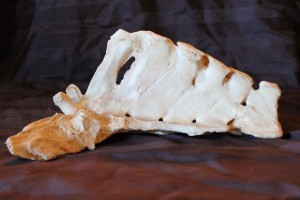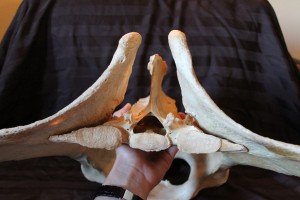The sacro-iliac joints, or “SI’s” for short, are a commonly discussed area of the horse. But where exactly are they, what do they look like, and why are they so important??? Read on to find out more!
Joints are always formed between two bones, in this case, the sacrum and the ili um, which is a term used for part of the pelvis, hence “sacro-iliac” joint. The sacrum is a part of the spine, and sits just behind the lumbar or low back vertebrae. It’s normally made up of five fused vertebrae, but variations may occur in up to 30% of horses according to studies done at MSU. If you look closely you will notice a variation in the one pictured here.
um, which is a term used for part of the pelvis, hence “sacro-iliac” joint. The sacrum is a part of the spine, and sits just behind the lumbar or low back vertebrae. It’s normally made up of five fused vertebrae, but variations may occur in up to 30% of horses according to studies done at MSU. If you look closely you will notice a variation in the one pictured here.
The pelvis is made up of three different areas, one being the ilium, which is the large flat area that forms the joint with the sacrum. On the picture below it is the broad flat part between the tuber sacral and the tuber coxae.

So, as mentioned previously, a joint is formed between two bones…now we need to stick them together!

So now that we have an idea of how the sacro-iliac joints are put together, lets talk a little bit about a few interesting points on the area in the live horse. First of all, this is the connecting point between the hind limb, which as we all know provides the horses impulsion, and the spine. This means that all of our impulsive forces are going to be transferred forward through this area. Secondly, the rest of the spine is attached to the sacrum. This means that the spine is literally “hanging” off the bottom of the pelvis…yes, the same spine that we as riders sit on. Of course there is a lot of soft tissue that helps to connect and support this area outside of the sacro-iliac joint, however this is the only place that connects the spine to the limbs (there is no bony attachment of the front limb to the spine or trunk of the body). The last point to consider is that the with the hind limb attached to the pelvis, there is a constant upward force on the pelvis from the horses weight. These things not only make these joints very important, but can also mean they are vulnerable to injury.

Lastly to help you place all of this into a live horse, see the picture below.


